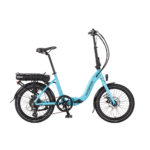I have made a spread sheet calculation of how a pulse width modulated controller may operate on a typical bike.
Four variations are shown below. All are based on a 26 volt battery.
Top left is my baseline using my guess of some typical parameters:15.7 A current limit together with a 278w power out limit, 0.2 Ohm resistance and a no load maximum speed for motor equivalent to 15.5 mph.
Top right shows the effect of increasing the motor resistance to 0.4 Ohms: Power above 12 mph is reduced. Low speed power is not affected. Efficiency falls.
Bottom left shows the effect of increasing current limit to 23 A and the power out limit to 400w. I think this would make the bike illegal.
Bottom right shows the effect of increasing the no load maximum speed for motor equivalent to 17 mph. and increasing the current limit to 17 A

I have chosen these parameters to see if I can reproduce what I understand to be the operation of the Panasonic motor and controller, which I have have read starts to limit power around 10.5 mph. So at this point I have assumed that the power limit comes into play. At lower speeds the controller will surely operate a current limit in order protect the battery. At speeds close to the maximum the reduction in power is caused by the rising back EMF of the motor and this reduces the power to zero at the no load maximum speed for motor.
I chose 287w as a power out limit on the basis that with 90% drive chain efficiency this would give 250 watts at the road/ tyre interface. Since that is what I assume the maximum continuous legal power of 250 watts implies. I have seen claims that the system will provide more power when climbing hills, It is not obvious to me how this is done, and in any case it would appear to me to breach the legal requirement.
I do not yet have a Panasonic powered bike to test this model against, but it appears to me to produce most of the features I have read about for this system with the exception of the control circuit which makes the assist proportional to the pedal torque provided by the rider. Presumably this works by further reduction to the pulse width percentage to try and match the motor power to that provided by the rider in accordance with the assist level which has been manually selected.
Four variations are shown below. All are based on a 26 volt battery.
Top left is my baseline using my guess of some typical parameters:15.7 A current limit together with a 278w power out limit, 0.2 Ohm resistance and a no load maximum speed for motor equivalent to 15.5 mph.
Top right shows the effect of increasing the motor resistance to 0.4 Ohms: Power above 12 mph is reduced. Low speed power is not affected. Efficiency falls.
Bottom left shows the effect of increasing current limit to 23 A and the power out limit to 400w. I think this would make the bike illegal.
Bottom right shows the effect of increasing the no load maximum speed for motor equivalent to 17 mph. and increasing the current limit to 17 A

I have chosen these parameters to see if I can reproduce what I understand to be the operation of the Panasonic motor and controller, which I have have read starts to limit power around 10.5 mph. So at this point I have assumed that the power limit comes into play. At lower speeds the controller will surely operate a current limit in order protect the battery. At speeds close to the maximum the reduction in power is caused by the rising back EMF of the motor and this reduces the power to zero at the no load maximum speed for motor.
I chose 287w as a power out limit on the basis that with 90% drive chain efficiency this would give 250 watts at the road/ tyre interface. Since that is what I assume the maximum continuous legal power of 250 watts implies. I have seen claims that the system will provide more power when climbing hills, It is not obvious to me how this is done, and in any case it would appear to me to breach the legal requirement.
I do not yet have a Panasonic powered bike to test this model against, but it appears to me to produce most of the features I have read about for this system with the exception of the control circuit which makes the assist proportional to the pedal torque provided by the rider. Presumably this works by further reduction to the pulse width percentage to try and match the motor power to that provided by the rider in accordance with the assist level which has been manually selected.







